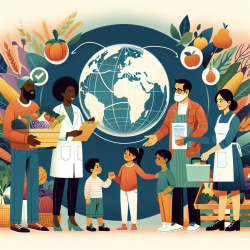Introduction
In the wake of the COVID-19 pandemic, the challenges of food insecurity have intensified, particularly for families with young children. A recent study published in the International Journal of Environmental Research and Public Health delves into the community stakeholders' perceptions of barriers and facilitators to food security for families with children under three years old. This research provides invaluable insights for practitioners seeking to improve their skills and outcomes for the children they serve.
Understanding the Barriers
The study identified several barriers to food security that existed before the pandemic and were exacerbated during it. These include:
- Lack of Awareness: Many families were unaware of their eligibility for federal assistance programs or how to access these resources.
- Stigma: There is a significant stigma associated with receiving benefits, which deters families from seeking necessary help.
- Logistical Challenges: Limited access to transportation and affordable housing further compounds the issue.
- COVID-19 Specific Barriers: The pandemic introduced new challenges such as fear of virus exposure and increased unemployment, impacting families' ability to secure nutritious foods.
Facilitators and Opportunities
Despite these barriers, the study also highlighted facilitators that can be leveraged to improve food security:
- Community Programs: Information and referral services, health promotion programs, and nutrition programs like SNAP and WIC play a crucial role in supporting families.
- Adaptation to COVID-19: Many organizations have adapted to the pandemic by offering virtual support and socially distanced services, ensuring continued access to resources.
Implications for Practitioners
Practitioners can draw several lessons from this study to enhance their practice:
- Increase Awareness: Educate families about their eligibility for assistance programs and how to access them. Utilize social media and community referrals to spread information.
- Reduce Stigma: Work towards normalizing the use of assistance programs by highlighting their benefits and sharing success stories.
- Leverage Technology: Use virtual platforms to provide support and resources, ensuring that families can access help even during crises.
- Policy Advocacy: Engage in advocacy to address systemic barriers and promote policies that ensure equitable access to nutritious foods for all families.
Conclusion
Addressing food insecurity requires a multifaceted approach that involves community stakeholders, policymakers, and practitioners. By understanding the barriers and facilitators to food security, practitioners can implement strategies that enhance access to nutritious foods and improve outcomes for young children. To delve deeper into the findings and implications of this research, you can read the original research paper by following this link: Community Stakeholders’ Perceptions on Barriers and Facilitators to Food Security of Families with Children under Three Years before and during COVID-19.










